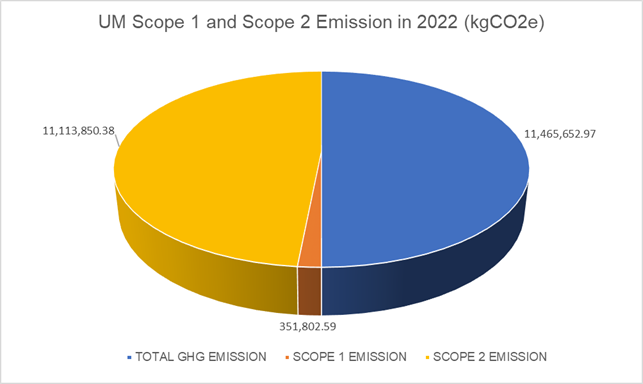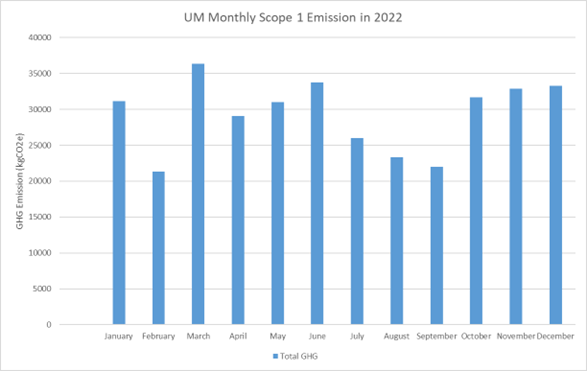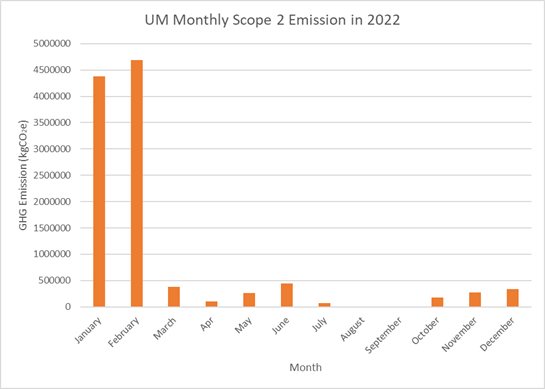Tracking Universiti Malaya's Greenhouse Gas Emissions in 2022

.jpg)
.jpg)
Universiti Malaya has adopted the GHG Protocol methodology for measuring our greenhouse gas (GHG) emissions. The approach used to measure the emissions is the control approach, where the organization accounts for 100 percent of the greenhouse gas emissions from operations over which it has control. The calculation takes into account emissions released within Universiti Malaya's main campus. Emissions released from Scope 1 and Scope 2 emissions were calculated according to the GHG Protocol.
The sources of greenhouse gas emissions are distributed across Universiti Malaya's main campus. Generally, the Department of Development and Estate Maintenance (known as JPPHB) is responsible for overseeing the maintenance and management of assets belonging to Universiti Malaya. However, due to the high volume of daily tasks and a shortage of manpower, certain maintenance responsibilities are delegated to engineers at the respective Centre of Responsibilities (PTjs). Responsibility for managing minor building maintenance, refueling, and other activities has been delegated to the engineers.
.png)
Scope 1 emission data, encompassing both mobile and stationary combustion, are maintained at each PTj. The PTjs keep a detailed logbook for recording information regarding vehicle usage. Additionally, each vehicle is equipped with a logbook, requiring users to document information such as the vehicle's mileage, fuel purchases in RM (Malaysian Ringgit), fuel usage in litres, total distance travelled, and the rate of fuel consumption. The data for fuel usage are not centralized at JPPHB. However, fuel usage data are not centralized within JPPHB but are dispersed across PTjs on UM's main campus, leading to challenges in data availability and accuracy. The data for fuel usage is not publicly available for reference. However, the data can be accessed upon request by contacting the Coordinator of the Transportation Section, Ts. Dr. Julia Mohd Nor at juliamn@um.edu.my.
Scope 2 emissions are related to indirect greenhouse gas emissions from the consumption of purchased electricity, heat, or steam. At Universiti Malaya, data on electricity consumption are mainly collected from utility bills provided by the energy supplier, which is Tenaga Nasional Berhad (TNB). These bills are centrally managed by JPPHB, overseen by the electrical engineering section under the physical maintenance division. This offers a more straightforward path for data collection compared to Scope 1. The utility bills provided by the electrical engineering section detail monthly electricity usage and monthly spending, allowing for an accurate calculation of Scope 2 emission based on the published emission factor by the Energy Commission (EC). The data for electricity usage is publicly available and can be accessed through the link https://jpphb.um.edu.my/utilities.
The study has encountered some limitations that need consideration. One significant challenge is the limited and unevenly distributed data on Scope 1 emissions across Universiti Malaya. The data's availability and accuracy vary across different PTjs. While some PTjs provide comprehensive 12-month data, others lack complete records, introducing potential uncertainties. Additionally, the study faced constraints in terms of time and manpower resources. The insufficient time and manpower dedicated to measuring greenhouse gas emissions hindered a comprehensive evaluation of Scope 3 emissions. Unfortunately, due to these constraints, the study could not extend its reach to include a thorough analysis of Scope 3 emissions, providing a limited perspective on the overall environmental impact of Universiti Malaya's activities.
The combined emissions from both Scope 1 and Scope 2 were determined to be 11,465,652.97 kgCO2e (11,465.65 tCO2e). Figure 1 illustrates the greenhouse gas emissions released by UM according to their scopes. Further details on the calculation methodology and breakdown for each scope are provided below.

Figure 1: Pie chart on UM Scope 1 and Scope 2 emission in the year of 2022
Scope 1 emission
The study calculated UM’s scope 1 emission from the year 2022. 2022 is also chosen as the baseline due to data availability, and business resumed as usual after the COVID-19 pandemic. The total emissions for Scope 1 emission were calculated based on the following equation:
Emissions (kgCO2e) = Quantity of Fuel Consumed (L or kg) × Emission Factor (kg CO2e per L or kg)
The emission factor used for calculating fuel combustion for both diesel and petrol are as follows:
Diesel: 2.60 kgCO2e/litre (Malaysia's Third Biennial Update Report to the UNFCC, 2020)
Petrol: 2.3228 kgCO2e/litre (Malaysia Green Technology and Climate Change Corporation)
The total greenhouse gas emissions for both diesel and petrol are 317,188.12 kgCO2e (317.19 tCO2e) and 34,614.47 kgCO2e (34.61 tCO2e) respectively. Thus, the total Scope 1 emission in 2022 for Universiti Malaya is 351,802.59 kgCO2e (351.80 tCO2e). Figure 1 represents the monthly greenhouse gas emission throughout the year of 2022.

Figure 2: Monthly greenhouse gas emission from Scope 1 emission in the year of 2022
Scope 2 emission
The Scope 2 emissions were calculated using data obtained from 2022. The same reason from Scope 1 is also applied to this scope. The total emissions for Scope 2 were calculated based on the following equation:
Emissions (kg CO2e) = Total kWh Consumed × Emission Factor (kg CO2e per kWh)
The emission factor used for calculating energy emissions is 0.780 kgCO2e/kwh from the Energy Commission (EC) in 2019. The total calculated greenhouse gas emissions for Scope 2 in 2022 is 11,113,850.38 kgCO2e (11,113.85 tCO2e). Figure 2 represents the monthly greenhouse gas emission coming from Scope 2.

Figure 3: Monthly Scope 2 emission in the year of 2022
In March 2022, Universiti Malaya (UM) subscribed to 5.5 million kWh of Green Electricity Tariff (GET) from Tenaga Nasional Berhad (TNB). GET represents electricity generated from renewable energy sources. This subscription accounts for the noticeable decrease in emissions starting from March, as emissions attributed to GET are assumed not to have produced any greenhouse gas emissions. UM has also received certification for the Malaysia Renewable Energy Certificate (mREC) in connection with this subscription.
This Greenhouse Gas tracking for Universiti Malaya is an initiative and contribution of one of the UM Carbon Neutrality Acceleration Living Lab projects under the purview of UM Sustainable Development Centre (UMSDC): LL2022CN003 - Dr. Fong Chng Saun (Institute of Advanced Studies - IAS UM) and his team on 'DEVELOPMENT OF A CENTRALIZED DIGITAL TOOL FOR LOCAL GREENHOUSE GAS (GHG) EMISSIONS'
References
Energy Commission (EC). (n.a). Grid Emission Factor (GEF) in Malaysia. Malaysia Energy Information Hub. https://meih.st.gov.my/documents/10620/384e88c1-b782-49a1-8dff-74c836b3a3f7
Ministry of Environment and Water Malaysia. (2020). Third Biennial Update Report to the United Nations Framework Convention on Climate Change. Ministry of Environment and Water Malaysia. https://unfccc.int/documents/267685
United States Environmental Protection Agency (USEPA). (2023). Scope 1 and Scope 2 Inventory Guidance. United States Environmental Protection Agency (USEPA). https://www.epa.gov/climateleadership/scope-1-and-scope-2-inventory-guidance
United States Environmental Protection Agency. (2023). Greenhouse Gas Reporting Program (GHGRP). United States Environmental Protection Agency. https://www.epa.gov/ghgreporting/learn-about-greenhouse-gas-reporting-program-ghgrp
Universiti Malaya Sustainable Development Centre (UMSDC). (2022). UM In Low Carbon Cities Framework (LCCF). Universiti Malaya Sustainable Development Centre (UMSDC). https://sustainability.um.edu.my/um-in-low-carbon-cities-framework-lccf
World Resources Institute & World Business Council for Sustainable Development. (2004). The Greenhouse Gas Protocol: A Corporate Accounting and Reporting Standard (Revised Edition). GHG Protocol. https://ghgprotocol.org/corporate-standard
Last Update: 08/04/2024